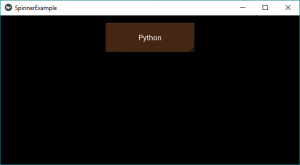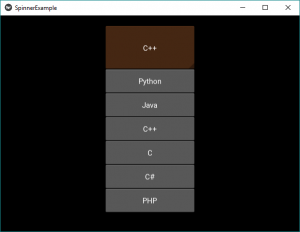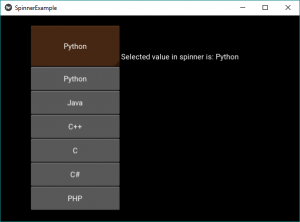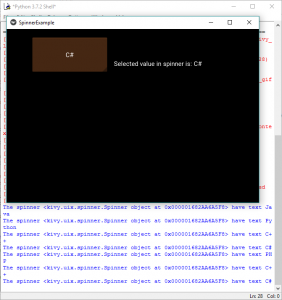Kivy是Python中与平台无关的GUI工具。由于它可以在Android, IOS, Linux和Windows等操作系统上运行。它基本上是用于开发Android应用程序, 但这并不意味着它不能在桌面应用程序上使用。
??Kivy教程–通过示例学习Kivy。
微调小部件:
要使用微调器, 你必须导入:
from kivy.uix.spinner import SpinnerSpinner是一个小部件, 提供了一种从一组中选择一个值的快速方法。在默认状态下, 微调器显示其当前选定的值。触摸微调器会显示一个下拉菜单, 其中包含所有其他可用值, 用户可以从中选择一个新值。
像组合框一样, 微调器对象可以具有多个值, 并且可以选择一个值。
回调可以附加到微调器对象上, 以接收有关从微调器对象选择值的通知。
Basic Approach :
1) import kivy
2) import kivyApp
3) import Label
4) import Spinner
5) import Floatlayout
6) Set minimum version(optional)
7) create App class:
1) Create the spinner
2) Attach the labels to spinners
3) Attach a callback also
8) return Layout/widget/Class(according to requirement)
9) Run an instance of the class一个简单的微调器的实现:
# Sample spinner app in kivy to change the
# kivy default settings we use this module config
from kivy.config import Config
# 0 being off 1 being on as in true /false
# you can use 0 or 1 && True or False
Config. set ( 'graphics' , 'resizable' , True )
# Program to Show how to create a switch
# import kivy module
import kivy
# base Class of your App inherits from the App class.
# app:always refers to the instance of your application
from kivy.app import App
# this restrict the kivy version i.e
# below this kivy version you cannot
# use the app or software
kivy.require( '1.9.0' )
# The Label widget is for rendering text.
from kivy.uix.label import Label
# Spinner is a widget that provides a
# quick way to select one value from a set.
# like a dropdown list
from kivy.uix.spinner import Spinner
# module consist the floatlayout
# to work with FloatLayout first
# you have to import it
from kivy.uix.floatlayout import FloatLayout
# Make an App by deriving from the App class
class SpinnerExample(App):
# define build
def build( self ):
# creating floatlayout
layout = FloatLayout()
# creating the spinner
# configure spinner object and add to layout
self .spinnerObject = Spinner(text = "Python" , values = ( "Python" , "Java" , "C++" , "C" , "C#" , "PHP" ), background_color = ( 0.784 , 0.443 , 0.216 , 1 ))
self .spinnerObject.size_hint = ( 0.3 , 0.2 )
self .spinnerObject.pos_hint = { 'x' : . 35 , 'y' :. 75 }
layout.add_widget( self .spinnerObject)
# return the layout
return layout;
# Run the app
if __name__ = = '__main__' :
SpinnerExample().run()输出如下:
图片1

图片2:

现在, 如果每次都要告诉用户选择列表中的哪个元素, 我们将在微调器旁边显示一个标签, 告诉你所选择的标签。另外, 我们将打印值和微调框的文本。
下面是实现:
# Sample spinner app in kivy to change the
# kivy default settings we use this module config
from kivy.config import Config
# 0 being off 1 being on as in true /false
# you can use 0 or 1 && True or False
Config. set ( 'graphics' , 'resizable' , True )
# Program to Show how to create a switch
# import kivy module
import kivy
# base Class of your App inherits from the App class.
# app:always refers to the instance of your application
from kivy.app import App
# this restrict the kivy version i.e
# below this kivy version you cannot
# use the app or software
kivy.require( '1.9.0' )
# The Label widget is for rendering text.
from kivy.uix.label import Label
# Spinner is a widget that provides a
# quick way to select one value from a set.
# like a dropdown list
from kivy.uix.spinner import Spinner
# module consist the floatlayout
# to work with FloatLayout first
# you have to import it
from kivy.uix.floatlayout import FloatLayout
# Make an App by deriving from the App class
class SpinnerExample(App):
# define build
def build( self ):
# creating floatlayout
layout = FloatLayout()
# creating the spinner
# configure spinner object and add to layout
self .spinnerObject = Spinner(text = "Python" , values = ( "Python" , "Java" , "C++" , "C" , "C#" , "PHP" ), background_color = ( 0.784 , 0.443 , 0.216 , 1 ))
self .spinnerObject.size_hint = ( 0.3 , 0.2 )
self .spinnerObject.pos_hint = { 'x' : . 35 , 'y' :. 75 }
layout.add_widget( self .spinnerObject)
self .spinnerObject.bind(text = self .on_spinner_select)
# It changes the label info as well
# add a label displaying the selection from the spinner
self .spinnerSelection = Label(text = "Selected value in spinner is: %s"
% self .spinnerObject.text)
layout.add_widget( self .spinnerSelection)
self .spinnerSelection.pos_hint = { 'x' : . 1 , 'y' :. 3 }
return layout;
# call back for the selection in spinner object
def on_spinner_select( self , spinner, text):
self .spinnerSelection.text = "Selected value in spinner is: %s"
% self .spinnerObject.text)
print ( 'The spinner' , spinner, 'have text' , text)
# Run the app
if __name__ = = '__main__' :
SpinnerExample().run()输出如下:
图片1

图片2:

以下是视频中的输出, 可以帮助你更好地理解:
首先, 你的面试准备可通过以下方式增强你的数据结构概念:Python DS课程。
 srcmini
srcmini
评论前必须登录!
注册